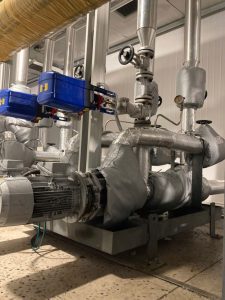Searching for a fixed “insulation jacket price list” often yields no accurate results because this is a product customized for each specific requirement. This article will analyze the core factors affecting cost and guide you on how to request an effective insulation jacket quote for 2025.
Why isn’t there a fixed price list for insulation jackets?
An insulation jacket, also known as an insulation blanket or a removable insulation cover, is a solution that is “tailor-made” for each type of equipment, pipe, valve, elbow, flange, etc. Unlike traditional insulation materials (sold by the meter or sheet), each insulation jacket is a unique product designed to fit the shape and technical requirements of the equipment perfectly.
Because each project has unique specifications regarding temperature, operating environment, and size, providing a general price list is not feasible. An insulation jacket quote is always prepared after the supplier has surveyed the site and gathered detailed information from the customer.
5 Key Factors That Determine Insulation Jacket Pricing
Understanding the factors that make up the cost will help businesses be more proactive in planning and budgeting.
1. Material Structure (3 Layers)
This is the most significant factor in the total cost. A standard insulation jacket consists of 3 layers, and the choice of material for each layer depends directly on the application:
- Outer Layer: Usually made from Silicone fabric, Teflon (PTFE) fabric, etc., which have good resistance to water, chemicals, UV rays, and abrasion.
- Middle Layer (Insulation): This is the “heart” of the product, typically using ceramic fiber, glass wool, or high-end materials like Aerogel. The thickness and density of this layer determine the insulation efficiency.
- Inner Layer: In direct contact with the hot surface of the equipment, it needs to withstand the highest temperatures. Common materials include fiberglass fabric or specialized stainless steel fabric.
2. Operating Temperature
The higher the surface temperature of the equipment, the more stringent the material requirements, especially for the inner and insulation layers. For example, for temperatures above 600°C, materials like ceramic fiber and stainless steel fabric are mandatory, leading to significantly higher costs compared to low-temperature applications.
3. Equipment Complexity
An insulation jacket for a straight pipe section will cost much less than one for a complex valve assembly, heat exchanger, or a joint with many details. Complex-shaped equipment requires more time for measurement, drawing design, cutting, sewing, and final assembly.
4. Installation Environment
- Indoors: The requirements for the outer shell are not overly strict.
- Outdoors / Chemical Environment: The insulation jacket needs a completely waterproof, UV-resistant, and corrosion-resistant outer shell (such as high-strength Teflon or Silicone fabric), which increases the material cost.
5. Quantity & Special Requirements
Ordering in large quantities usually results in a better unit price per product. Additionally, special requests such as adding inspection flaps, ventilation holes, identification tags, or using special heat-resistant fastening straps will also be factored into the final quote.
How to Get a Fast and Accurate Insulation Jacket Quote?
To receive the fastest and most accurate quote, you need to provide the manufacturer with the following information:
- Equipment Information: Provide the name and actual photos of the valves, elbows, pipes, machinery, etc., that need insulation.
- Detailed Dimensions: Measure basic dimensions such as length, diameter, and circumference. For complex equipment, the supplier will often need to conduct an on-site survey.
- Surface Temperature: What is the maximum operating temperature of the equipment in degrees Celsius?
- Installation Environment: Is the equipment located indoors, outdoors, or in an area with chemicals?
- Quantity: The number of insulation jackets needed for each type of equipment.
- Other Requirements (if any): Clearly state any requirements for color, accessories, etc.
Based on this information, the technical team will analyze, select the optimal materials and construction methods, and send you a detailed and competitive quote. For a free consultation and quote, please contact us today!
Request consultation and quotation now!Frequently Asked Questions
What are insulation jackets made of?
An insulation jacket typically has 3 layers: a waterproof outer layer (Silicone/Teflon fabric), a middle insulation layer (ceramic fiber, Aerogel), and a high-temperature resistant inner layer (fiberglass fabric, stainless steel fabric).
What is the average lifespan of an insulation jacket?
The lifespan of an insulation jacket can range from 3-7 years or more, depending on the material quality, working environment, and the frequency of removal and reinstallation for maintenance.
How does the cost of an insulation jacket compare to fixed insulation?
The initial investment cost may be higher, but removable insulation jackets save money in the long run due to their easy removal for maintenance and inspection, without needing to destroy and replace the insulation.
Are insulation jackets reusable?
Yes, this is a major advantage. Insulation jackets are designed to be removed and reinstalled multiple times, which saves costs whenever the equipment inside needs maintenance or repair.










